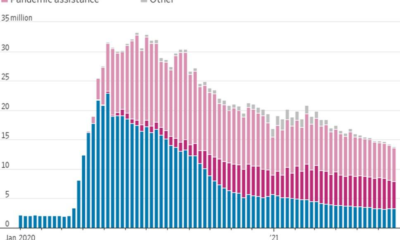Real Estate
The Manhattan Real Estate Market May Be At An Inflection Point: Watch These Categories – Forbes

As Manhattan real estate begins the fall busy season, time will tell if this recovery cycle has … [+]
As Manhattan real estate enters the fall busy season, it bears asking: What does the market look like today, and where is it headed? After recovery from the pandemic lows last year, the market appears poised for further gains. There are four primary points that we can look at that suggest Manhattan may be at an inflection point: Inventory, demand, market “feel,” and price action.
From November 2020 through August 2021, Manhattan experienced a sustained net deficit of new inventory when considering contracts signed and listings removed from the market. The fresh wave of listings that hit the market post-Labor Day should reverse this squeeze temporarily. However, with demand remaining at elevated levels, any reversal may be temporary. Today’s buyers may have a window of opportunity to find and negotiate on a home before the next wave of contract action hits in early October.
Net Negative | New supply still under pressure despite surge of fresh listings.
Busy seasons in real estate begin with sellers and end with buyers — new listings come on the market, and several weeks later, signed contracts take them off.
As the first month of the busy fall season, September usually sees high listing activity but low contract activity because buyers have not had enough time to get deals done. As a result, the pending sales number for September tends to hover between 2,000 and 3,000 units. However, September 2021 showed over 4,500 units in contract, clearly demonstrating how far above historical norms recent deal volume has been, and hinting that activity will remain at elevated levels toward the end of the year.
September to Remember | Pending sales at the end of summer since 2011
A look at the ratio of pending sales to active listings quantifies how the market “feels,” and provides a window into the market’s pulse.
As the ratio rises, sellers gain leverage, and as it falls, buyers gain leverage. This real-time gauge is separate from price action, which usually takes several months to fully manifest. The chart below illustrates what the Manhattan real estate market felt like since it reached its peak in mid-2015. Notice how the leverage slowly and steadily shifted from sellers to buyers culminating in a deep buyer’s market during the COVID-19 pandemic lockdown, and then quickly reverted to a strong seller’s market in 2021 as demand began eclipsing supply. Even though it’s still a seller’s market, the post-Labor Day influx of listings pushed the ratio down in September, suggesting that buyers have more leverage now than the last several months.
Manhattan Market Pulse | Demand-to-supply ratio indicating leverage
Manhattan has vast spectrums of price points and property types, which makes tracking price action tricky. The old standby, median sales price, is a broad look across all sales and is more a function of the size and type of properties sold. Price per square foot yields a more linear view, but most of Manhattan’s housing stock are co-ops with no verifiable data on apartment size.
On the other hand, condos offer a recorded and measurable unit size. Unfortunately, new development condo prices tend to skew far higher than average. Removing new developments from the mix leaves resale condo price per square foot as a more precise way of looking at market-wide price action, especially when measured by the month of contract signing.
In the chart below, the general price trend since 2003 is visible. The dashed lines represent pre-pandemic resistance and support levels, and roughly outline the channel Manhattan price action was trading in at that time. Notably, Manhattan prices have slowly fallen since 2015, and even dipped below the bottom support level, suggesting an oversold market. The recovery in activity has started to reverse this course, and, at present, the general price trend is back in its channel, albeit on the low-end. With demand remaining high in the near term, current price levels may appear as a relative value when viewed over the longer term. On the contrary, should market conditions deteriorate, the recently crossed support line may serve as resistance.
Resale Condo Price Per Square Foot | Monthly median by contract signed date
The Manhattan market is well into its recovery from the pandemic lows experienced during the middle of last year. A recent influx of new inventory has eased supply pressures. Still, with liquidity running at a very high level, an environment of lower supply may appear during the next active season. Prices should continue to trend upwards as the bounce off COVID lows continues, and the pipeline of signed deals over the frenetic summer months closes.
Sellers may be confused that prices are only back to 2019 levels while the market activity in the streets feels more like 2015 or 2016 levels, but the data is clear: We have only recovered 2020’s “COVID discount.” There is a way to go before prices start notching new highs.
As Manhattan real estate begins the fall busy season, time will tell if this recovery cycle has enough buyers in reserve to keep progressing or if a pause is in the works. Either way, today’s buyers have more choice than they have had in several months, with prices seemingly headed higher.
Real Estate
Central banks end crisis-fighting measure as bank tumult recedes

Last month, the collapse of Silicon Valley Bank, the second-largest bank failure in US history, unleashed broader panic and raised fears the global financial system would seize up. Now, central banks are signaling that their immediate concerns have eased.
The Bank of England, the Bank of Japan, the European Central Bank and the Swiss National Bank said Tuesday that they would end daily measures to boost the flow of US dollars to lenders around the world. They cited “improvements in US dollar funding conditions” and “low demand” at recent operations aimed at providing liquidity.
Starting May 1, those operations will once again be held weekly, a decision made in consultation with the US Federal Reserve, the primary source of dollars. The frequency could increase again if needed, the four central banks said.
“These central banks stand ready to readjust the provision of US dollar liquidity as warranted by market conditions,” they said in their statements.
Policymakers sprung into action in March after the collapse of Silicon Valley Bank and Signature Bank in the United States sparked an acute bout of turmoil in the global banking sector. The tumult also nearly took down Credit Suisse (CS), a globally important but troubled bank, forcing Swiss authorities to arrange an emergency sale to rival UBS (UBS).
Hours after the Credit Suisse takeover was announced, the Fed said it would work with central banks in the United Kingdom, Japan, Canada, Switzerland and the European Union to make sure lenders there had access to the dollar liquidity they needed.
That meant making greater use of dollar swap lines, or agreements between the Fed and other central banks to provide dollars in exchange for, say, euros or yen.
Swap lines are a key instrument in central banks’ toolbox aimed at preserving financial stability and keeping credit flowing to households and businesses.
Real Estate
Fukushima’s fishing industry survived a nuclear disaster. 12 years on, it fears Tokyo’s next move may finish it off

It is still morning when Kinzaburo Shiga, 77, returns to Onahama port after catching a trawler full of fish off Japan’s eastern coast.
But the third-generation fisherman won’t head straight to market. First, he’ll test his catch for radiation.
It’s a ritual he’s repeated for more than a decade since a devastating earthquake and tsunami triggered a nuclear meltdown at the Fukushima Daiichi power plant in 2011, spewing deadly radioactive particles into the surrounding area.
Radiation from the damaged nuclear plant leaked into the sea, prompting authorities to suspend fishing operations off the coast of three prefectures that had previously provided Japan with half of its catch.
That ban lasted over a year, and even after it was lifted, Fukushima-based fishermen like Shiga were for years mostly limited to collecting samples for radioactivity tests on behalf of the state-owned electricity firm Tokyo Electric Power Company, or TEPCO, rather than taking their catches to market.
Ocean currents have since dispersed the contaminated water enough that radioactive cesium is nearly undetectable in fish from Fukushima prefecture. Japan lifted its last remaining restrictions on fish from the area in 2021, and most countries have eased import restrictions.
Shiga and others in the industry thought they’d put the nightmare of the past years behind them.
So when Japan followed through on plans to gradually release more than 1 million metric tons of filtered wastewater into the Pacific Ocean from the summer of 2023 – an action the government says is necessary to decommission the plant safely – the industry reeled.
The Japanese government and the International Atomic Energy Agency (IAEA), a United Nations body promoting the peaceful use of nuclear energy, say the controlled release, which is expected to take decades, will meet international safety regulations and not harm the environment, as the water will be treated to remove radioactive elements – with the exception of tritium – and diluted more than 100 times.
But with the deadline for the planned water release looming this summer, Fukushima’s fishermen fear that – whether the release is safe or not – the move will undermine consumer confidence in their catches and once again threaten the way of life they have fought so hard to recover.
Real Estate
Video shows US police at wrong house before shooting homeowner

Robert Dotson, 52, was killed by police on April 5 in New Mexico after officers responding to a domestic violence report arrived at the wrong house.
New Mexico police officers realised they were at the wrong address just moments before the front door opened and they fatally shot the armed homeowner, then exchanged gunfire with his wife, according to newly released body camera video of the April 5 shooting.
Robert Dotson, 52, was killed in Farmington, a city of 47,000 people in the southwestern US state, after officers on their way to a domestic violence call went to the wrong house.
The Farmington Police Department released several videos on Friday, including footage captured by body cameras worn by the three officers who fired their weapons.
“All of us – the men and women of the Farmington Police Department – recognise the severity of this incident,” Police Chief Steven Hebbe said in a statement.
“Once again, we wish to express our condolences to the Dotson family, and as your chief of police, I wish to convey how very sorry I am that this tragedy occurred,” Hebbe said.
-

 Business3 years ago
Business3 years agoHyundai Leads Industry in U.S. News & World Report 2023 Best Cars for the Money Awards
-

 Innovation3 years ago
Innovation3 years agoJay-S ventures into the urban genre with “Bailar en la Playa” his latest production
-

 Business3 years ago
Business3 years agoThree Questions Small Business Owners Should Ask In Creating A Workplace Culture – Forbes
-

 Business3 years ago
Business3 years agoA Fintech Makes It Easy For Small Businesses To Offer 401(k) Retirement Benefits – Forbes
-

 Business3 years ago
Business3 years agoBritain’s Small Businesses See Better Times Ahead But Is Their Optimism Justified? – Forbes
-

 Money3 years ago
Money3 years agoCharlie Crist leads Democratic gubernatorial field again in money chase – Florida Politics
-

 Money3 years ago
Money3 years agoTesting New Tools for Horizon Worlds Creators To Earn Money
-

 Business3 years ago
Business3 years agoSmall Business Labor Shortage – Forbes
